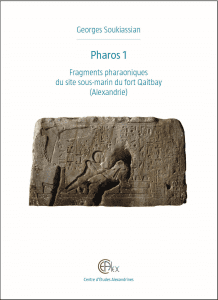
Fragments pharaoniques
du site sous-marin du fort Qaitbay
(Alexandrie)
Georges Soukiassian
- ISBN : 978-2-490128-21-1 - ISSN : 1110-6441
contacter le service des publications
Ancien membre de l’Ifao (1981-1985),
archéologue de l’Ifao (1985-2013),
puis du CEAlex (2013-2018), GEORGES SOUKIASSIAN a participé aux travaux sous-marins menés par le CEAlex au pied du Fort Qaitbay
depuis la première campagne en 1994.
To the east of the Qaitbay fort (1477-1479) built on the former site of the Pharos of Alexandria, the underwater site consists of a mass of ancient blocks covering an area of 115 m N/S by 140 m E/W, at a depth of 5 to 8 m. Among the 4081 blocks inventoried, 35 pharaonic fragments, most of them inscribed, are published here in a catalogue. Of these, 19 are now exhibited in the Open Air Museum at Kom el-Dikka. They include fragments of two pairs of obelisks of Sethi I, architectural remains such as closed papyriform columns and architraves of Apries, and sphinxes, the oldest of which is inscribed with the name of Sesostris III and the most recent with the name of Psametik II. Published with the support of the Jean Leclant Foundation (Académie des Inscriptions et Belles Lettres, Jean and Marie-Françoise Leclant Prize 2016) and of the Honor Frost Foundation.
À l’est du fort de Qaitbay (1477-1479) bâti sur l’ancien emplacement du Phare d’Alexandrie, le site sous-marin consiste en un chaos de blocs antiques couvrant une surface de 115 m N/S par 140 m E/W, à une profondeur de 5 à 8 m. Parmi les quelque 4 081 blocs inventoriés, 35 fragments pharaoniques, la plupart inscrits, sont ici publiés sous forme de catalogue. Dix-neuf d’entre eux sont aujourd’hui exposés au Musée de plein air du site de Kôm el-Dikka. Ils comprennent les fragments de deux paires d’obélisques de Sethi Ier, des vestiges architecturaux tels que des colonnes papyriformes fermées et des architraves d’Apriès, des sphinx dont le plus ancien est inscrit au nom de Sésostris III et le plus récent au nom de Psammétique II. Ouvrage publié avec le soutien de la Fondation Jean Leclant (Académie des Inscriptions et Belles Lettres, prix Jean et Marie-Françoise Leclant 2016) et de la Honor Frost Foundation.
إلى الشرق من قلعة قايتباي (۱٤۷۷-۱٤۷۹) التي شُيدت في موقع فنار الإسكندرية القديم، نجد الموقع المغمور الذي يتألف من قطع أثرية متناثرة تتفرش القاع على عمق يتراوح بين خمسة وثمانية أمتارً وعلى مساحة تقدر بمئة وخمسة عشر مترًا شمالًا جنوبًا في مئة وأربعون مترًا شرقًا غربًا. وتضم القطع التي تم حصرها بالموقع، والتي يصل عددها إلى حوالي ٤۰۸۱ قطعةً أثريةً، ۳٥ قطعة فرعونية، تحمل أغلبها كتابات، ننشرها في هذا المجلد، وقد تم عرض ۱۹ قطعة منها في المتحف المفتوح بموقع كوم الدكة. وتشمل تلك القطع الفرعونية أجزاءً من زوج مسلات أقامها الملك سيتي الأول وبقايا معمارية مثل أعمدة بردية ذات تيجان مغلقة وسواكف تعود لعهد الملك أبريس وتماثيل بهيئة أبو الهول تحمل أقدمها اسم الملك سيزوستريس الثالث وتحمل أحدثها اسم الملك بسماتيك الثاني
نُشر هذا المجلد بدعم من مؤسسة چان لوكلان (أكاديمية النقوش والآداب، جائزة چان وماري فرنسواز لوكلان ۲۰۱٦
